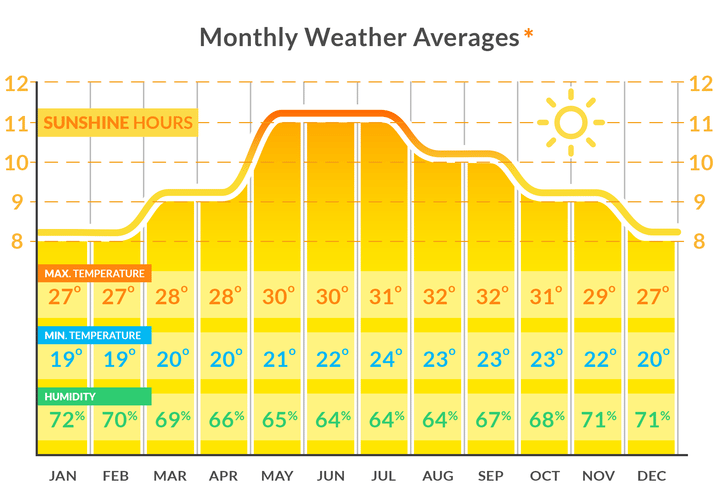Flowers are always in bloom in Hawaii. That is because the Hawaii weather is warm and very consistently warm throughout the year with only minor changes in temperature and rainfall.
 The Hawaii Weather Seasons
The Hawaii Weather Seasons
There are really only 2 seasons in Hawaii:
Summer (called Kau in Hawaiian) from May to October and
Winter (called Hooilo in Hawaiian) from November to April.
The average daytime summer temperature at sea level is nearly 30°C while the average daytime winter temperature is around 25°C. Night time temperatures are approximately 5ºC lower.
Hawaii is close to the Equator so its weather is tropically warm and consistent throughout the year. And with eight to twelve hours of sunshine guaranteed every day, there is not a lot to complain about with the Hawaii weather.
Rainfall
The months of April – October tend to have less rain than the months of November – March.
Most rainfall in Hawaii rainfall is overnight. Even if a rain shower should interrupt your day, it rarely lasts more than a few minutes before the glorious sunshine breaks through again. You may even be treated to a rainbow afterwards.
Island Variations
The weather on each Hawaii island is slightly different. This is because the weather is very much influenced by the trade winds which generate windward and leeward regions. In general, the north and east facing coasts tend to get more rain than the south and west-facing coasts.
The tall volcanic mountains of Hawaii are significantly colder than the coastal areas. Rising to over 13,000 feet above sea level, it’s not unusual for Mauna Kea and Mauna Loa on the Big Island to get snow in the winter.
The southern side of Oahu, including Waikiki and Honolulu along with the southwest coast at Ko Olina are your best bet for lots of Hawaiian sunshine. With the North Shore also gets plenty of sunshine, don’t hesitate to head to any part of Oahu any day of the year.
Choose the sunny South Coast near Wailea for a nearly guaranteed sunshine all year round. While, Lahaina Kaanapali and Kapalua in West Maui get a bit more rain as compared to South Maui, overall the area has relatively low rain levels and good amounts of beautiful Hawaiian sunshine.
The windward east side of Maui, including beautiful Hana, tend to have a more rain which creates those beautiful waterfalls and rainforests.
If you plan to venture to the top of Maui’s inactive volcano, Haleakala, plan to bring a warm windproof jacket, hat and gloves as it can get cold – especially during the night.
Further Information About Hawaii:
- An Overview of Hawaii
- Accommodation & Places to Stay
- Places of Interest
- How to Get There
- Local Cuisine
- Things to Do in Hawaii
- A Brief History of Hawaii
